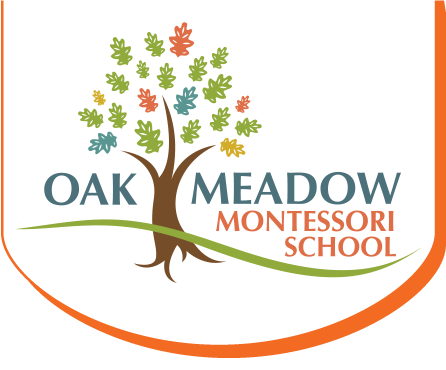This week I spent an entire school day in our Middle School, going to all of the classes, learning more about what our students do each day, and better appreciating what makes our Middle School quite exceptional. I talked with the students and teachers ahead of time, and explained that I wanted to get as much of a “student’s-eye view” as I possibly could. I dressed casually, sat with the students, and participated when possible. In PE class I did a warm-up activity as well as fast walking and tagging, and when I wiped out on the gym floor, the students were kind enough not to laugh, even though it was pretty funny. It was a great opportunity to spend the day with our wonderful Middle Schoolers. Let me share some details.
Class sizes are often no more than 10 or 12 students. Even when the whole middle school is in a single class, such as Humanities, students often break up into smaller groups ranging from two students to seven students. This allows the teachers to provide more personalized attention, and to ensure that each student is being appropriately challenged at their own pace.
I observed every student actively participating in discussions, debates, critical thinking, skill-building, and problem solving. Teachers were personally connected with the students, providing just the right amount of guidance, encouraging students to pursue their own lines of reasoning and research, and designing an environment that intentionally created space for students to figure out challenges on their own.
The academic depth of the conversations I heard among the students was extraordinary. Students clearly found the topics interesting, challenging, thought-provoking, and connected authentically to the real world. Students were provided with an environment that encouraged their individual voices to be heard and appreciated. When there were debates, there was a noticeable sense of valuing the individuality and diversity of the perspectives of peers. Middle schoolers are of course adolescents, and this is naturally a time that includes various social pressures and social behaviors. Oak Meadow is a wonderful middle school exactly for this reason, because the teachers understand these ages, are dedicated to working with children in the middle school years, and create an environment that expresses appreciation and respect for each individual student.
After spending 23 years as an educator and administrator in schools with middle-school programs, I can say from experience that Oak Meadow’s Middle School is truly distinctive and exceptional.
Here was my schedule from this past Wednesday:
Community meeting: 8:15-8:45
Humanities: 8:45-9:45
Mindfulness: 9:45-9:55
Science Lab/Art:10:00-11:00 (students split into separate classes)
Algebra: 11:00-12:00
PE 1:00-1:45
Science: 1:45-2:35
Honors Algebra/Honors Geometry: 2:35-3:25
Chores/Dismissal: 3:25-3:40
Here are a few observations from each classroom visit:
Community Meeting 8:15-8:45:
Students are seated on chairs and comfortable sofas spread throughout the Great Room. The space receives lots of natural lighting from the adjacent courtyard, and walls are filled with the products and activities of student work. Teachers open the morning with a warm greeting. Announcements are made about Veterans Day and the Camp Kieve trip next week.
The rest of the meeting time is spent with students working in groups on the “student businesses” they have designed. The Middle School businesses provide an opportunity for students to design their own business concepts that will be financially sustainable, and then implement their ideas in the school community. They learn to work as a team, overcome obstacles, become more independent, and adapt their concepts in order to be successful. Three business teams meet this morning: (1) a digital magazine written by Middle School students for Upper Elementary and Lower Elementary students, (2) a raffle basket that will allow each class in the school to design their own gift basket, and (3) holiday bags that students will be able to assemble in the Rizzi center by adding the items they wish to include.
The teacher chimes in, “This morning you need to refine your ideas as a team, think through the logistics, and then plan for a roll-out of your business concept in January. In your roll-out, you need to anticipate the questions you will receive from the community.” With that guidance the three teams move to separate classrooms to get to work.
Within the digital magazine team, students are debating if it’s possible to have one magazine for both Upper Elementary and Lower Elementary. “What if we had a section in the magazine just for LE students?” Each student shares their viewpoint. The teacher adds, “You might want to start by building a prototype,” and the students begin working on sketching their ideas.
Humanities 8:45-9:45
All Middle School students participate in this hour-long period as they prepare for an upcoming debate. The students have formed into three groups, based on the book they’re reading, The Omnivore’s Dilemma. Each group is deeply researching one specific food chain model: (1) local sustainable, (2) industrial organic, and (3) hunter gatherer. The teacher has carefully created the framework for the upcoming team debate by providing formats that help students clarify their own position statement, identify supporting evidence, and develop counterarguments that are likely to be used by opposing groups. Each group has about 7 students. The discussions are animated, with everyone sharing their ideas and looking for evidence to back-up their position.
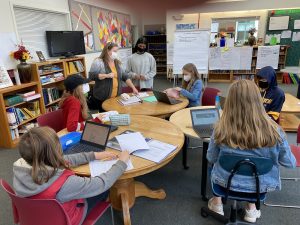 The teacher counsels, “You’ve made good arguments to back up your position. You also need to identify strong opposing viewpoints. What will hunter-gatherers say against local-sustainable? You need to think about this from their viewpoint.” One of the students says, “They’ll say our approach is too expensive, and we’re not getting our own food.” “That’s good to start,” responds the teacher. “You’ll need to think more about this from their perspective. You will need to anticipate and predict what the other group will say in opposition to local-sustainable, and you’ll have to find holes in their arguments so that you have a strong rebuttal.” The whole group jumps back into discussion.
The teacher counsels, “You’ve made good arguments to back up your position. You also need to identify strong opposing viewpoints. What will hunter-gatherers say against local-sustainable? You need to think about this from their viewpoint.” One of the students says, “They’ll say our approach is too expensive, and we’re not getting our own food.” “That’s good to start,” responds the teacher. “You’ll need to think more about this from their perspective. You will need to anticipate and predict what the other group will say in opposition to local-sustainable, and you’ll have to find holes in their arguments so that you have a strong rebuttal.” The whole group jumps back into discussion.
The teacher explains to me, “One goal is to identify the author’s purpose, what evidence they use to support their claim, and determine if the author’s reasoning is relevant. Another goal is to have students create a claim, find evidence to support it, and explain why that evidence is relevant to the claim. Additionally, each group will have to identify a counter argument and construct a response to defend their claim. The final task is to present their argument to the class, with each group having the opportunity for rebuttal. Each student will then write up their argument as a culminating writing assignment.”
Mindfulness (9:45-9:55)
Following two, intense, back-to-back, small-group problem solving discussions, the students have a 10-minute “mindfulness” break built into their schedule. This only happens once a week, on Wednesdays. The teacher tells me, “Our days are go-go-go, so this offers a break once a week.” Relaxing music plays. The students all transition back into the Great Room. Some eat a snack they’ve brought from home. Others are reading or relaxing with their eyes closed. Quiet conversations occur among a few students, and some are playing quiet games. One student is lying on the floor, and another is sitting at a table with her head on the table, resting. One student is sketching in a journal. Even for me, this 10-minute break feels like a nice change after a morning of busy group work.
Science Lab (10:00-11:00)
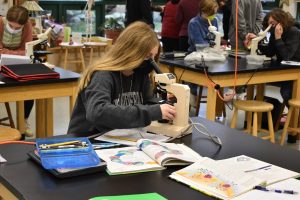 This class of ten students is focusing on cells and heredity. They are learning about the science of heredity and developing a better understanding of modern genetics. Understanding the science terminology is important, such as genes, alleles, probability, phenotypes, genotypes, and dominant and recessive traits. Today’s lab is not typical, since the students are traveling to Camp Kieve next week and will not have time to complete a regular lab assignment. So today the lab is something fun they can complete during the class period.
This class of ten students is focusing on cells and heredity. They are learning about the science of heredity and developing a better understanding of modern genetics. Understanding the science terminology is important, such as genes, alleles, probability, phenotypes, genotypes, and dominant and recessive traits. Today’s lab is not typical, since the students are traveling to Camp Kieve next week and will not have time to complete a regular lab assignment. So today the lab is something fun they can complete during the class period.
Students break into groups to use what they know about heredity and to practice using the Punnett Square to calculate the probability of the traits of a baby monster produced by two monster parents. Each pair of students must make sure their baby monster phenotype matches the Punnett Square in terms of eye size, eye color, skin color, tail shape, tail color, teeth shape, number of toes, horn color, ear shape, claw length, nose size, and number of fingers. Although they work in pairs, each student is required to go through all of the steps in the activity and turn in their individual work, including a drawing of their baby monster.
Art: (10:00-11:00)
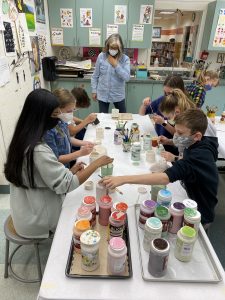 The Art Studio is a beautiful space, brightly lit, with long tables, and surrounded by amazing materials and completed pieces. Although everyone is focused on adding glaze to their ceramic creations, the environment is naturally conducive to informal conversation, making this both a time for creativity and social interaction. The teacher checks in with each student, offers guidance, and gives encouragement. There’s real pride in what each student creates, and students express appreciation for what others have created. Students all enjoyed telling me more about their creations. The humanities teacher has joined them, and has made her own creation.
The Art Studio is a beautiful space, brightly lit, with long tables, and surrounded by amazing materials and completed pieces. Although everyone is focused on adding glaze to their ceramic creations, the environment is naturally conducive to informal conversation, making this both a time for creativity and social interaction. The teacher checks in with each student, offers guidance, and gives encouragement. There’s real pride in what each student creates, and students express appreciation for what others have created. Students all enjoyed telling me more about their creations. The humanities teacher has joined them, and has made her own creation.
The art teacher tells me, “This is the final class in a unit on Art and Nature which the students started in September. They have worked on several different projects. Most of them will be glazing clay pieces that they have worked on in the past two weeks. Based on the work of Andy Goldsworthy, students have explored a variety of materials and used them to explore how nature can be used as an inspiration or a material for artmaking. They are also learning how to plan, pace, and complete a project on time. Within those goals or structures they are learning from mistakes and seeing challenges before, during, and after.”
Algebra: (11:00-12:00)
 There are four students in this class. All of the students are engaged and involved in the work at hand. Students regularly come up to board and complete diagrams or equations on their own. Every student makes several trips up to the board to work on a problem in front of the group. Every student is engaged in a question-and-answer format.
There are four students in this class. All of the students are engaged and involved in the work at hand. Students regularly come up to board and complete diagrams or equations on their own. Every student makes several trips up to the board to work on a problem in front of the group. Every student is engaged in a question-and-answer format.
“Looking at the equation alone,” the teacher asks, “which lines are parallel? What does it mean to be parallel?” Students go up to the board to circle the equations that have the same slope. “What does it mean to be perpendicular?” After a discussion, everyone agrees that they are opposite reciprocals. If the slope of a line is 3, it’s opposite reciprocal is -⅓. “If the square root of x is equal to 121, how do we get that answer?” The students figure out that x must be equal to 14,641. Students then work on assignments at their desk, work that must be turned in at the end of class.
What I observe is that there is a real focus on providing opportunities for the students to practice solving problems in a variety of ways, as well as making sure the students understand the concepts deeply.
PE: (1:00-1:45)
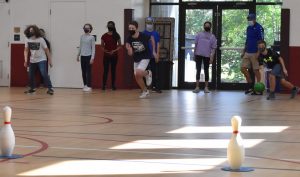 The PE class begins with activities that involve stretching in a game working with a partner. This is followed by an activity with a partner that involves walking very quickly (no running allowed), tagging, and turning in place. All of this builds to a culminating relay race with the whole class working in teams of about 4 students selected by the teacher. Everyone runs a lap at full speed, and then gets a chance to rest and recover while 3 team members take up the running. There is music playing in various activities, with the music from Rocky used in the final relay race championship.
The PE class begins with activities that involve stretching in a game working with a partner. This is followed by an activity with a partner that involves walking very quickly (no running allowed), tagging, and turning in place. All of this builds to a culminating relay race with the whole class working in teams of about 4 students selected by the teacher. Everyone runs a lap at full speed, and then gets a chance to rest and recover while 3 team members take up the running. There is music playing in various activities, with the music from Rocky used in the final relay race championship.
The teacher shared with me, “My essential goals are safety, body management skills, promoting physical fitness is fun, developing teamwork, sportsmanship, cooperation, and improved social skills. My design is to create a balanced class, with different age appropriate activities/tasks and games that make kids’ hearts leap. I challenge all students to be their best and to give their best. My approach to working with students is getting to know them (strengths/weaknesses), and to set up activities that are active, purposeful, promote success, inclusiveness, and help create an enjoyable class for every student.
Science Class (1:45-2:35)
The regular science class continued to follow up on how the characteristics of parents are passed along to offspring. Specifically, this class focused on the probability of parents passing along traits to their offspring. Students created a document with a data table to record 200 trials. They recorded the results of tossing a coin and seeing how often it landed on heads. Students had to calculate the probability for the first 5 trials, then 10 trials, then 20, 50, 100 and 200, recording the percentage of heads vs. tails. They also had to look at their data to determine the probability of flipping heads two times in a row, three times in a row, and four times in a row. That becomes important in determining the probability of more than one event occurring.
The teacher shared with me, “Students are learning about probability and conducting a lab-like activity making predictions and calculating the probability of an event. This connects to the probability of genes getting passed on in heredity. My goal is for students to understand key vocabulary connected to genetics and heredity and to be able to use this fluently to discuss the topic at hand.
Algebra Honors (2:35-3:25)
There are 6 students in this class. All of the students are sitting at the front of the classroom, and regularly get up from their seats to work out problems on the WebEx board. All of the students are engaged, asking questions, and working at solving complex problems. Students go to the interactive board, draw triangles, and calculate the length of the diagonal line using the Pythagorean theorem. Students also find the distance between two pairs of points, and round their answer to the nearest 10th.
The teacher shares with me that the students take notes on the distance formula, apply the concept, and then practice the skills of using it. The objective of the lesson is to see the connection between the Pythagorean theorem and the distance formula and be able to apply it given 2 points abstractly.
Geometry Honors (2:35-3:25)
There are 3 advanced students in this class. These are students who have demonstrated a high level of mastery in the Middle School math curriculum and have shown an ability to work independently and complete their assignments. They begin by meeting in the back of the Algebra Honors classroom. The teacher meets with them briefly to go over their assignment and see if they have any questions. The three students then move to an empty classroom next door and complete the assignment on their own.
The teacher explains, “Honors Geometry started a new unit today and they are exploring how parallel and perpendicular lines can be identified. The objective is for them to relate slope and parallel lines (same) and slope and perpendicular lines (opposite reciprocal slopes)
Follow up is for them to investigate the construction method to parallel and perpendicular lines using folding paper and transformations. The Geometry students are given minimum objectives to reach for each class and follow up assignments. Students work at their own pace with bare minimum objectives clearly stated. Geometry students are given feedback for each paper-based assignment (these are known as “Checks for Understanding”), which is usually given back to me the next day.”
Chores (3:25-3:40)
Students are assigned to various chores at the end of each school day, with chores rotating so that all students share equally in the work. Tables are wiped down. Chairs are stacked. All of the easel sheets that have been spread throughout the middle school are returned to their proper location on the walls of the Great Room, ready for use again the next day. A whiteboard is used to remind students about homework due the next day, as well as longer-term assignments. Students pack their belongings and prepare to end the school day. There are a few minutes for any announcements or closing comments. As one teacher expressed to me, “There is a wonderful feeling of shared responsibility for the community and caring for the environment.”
